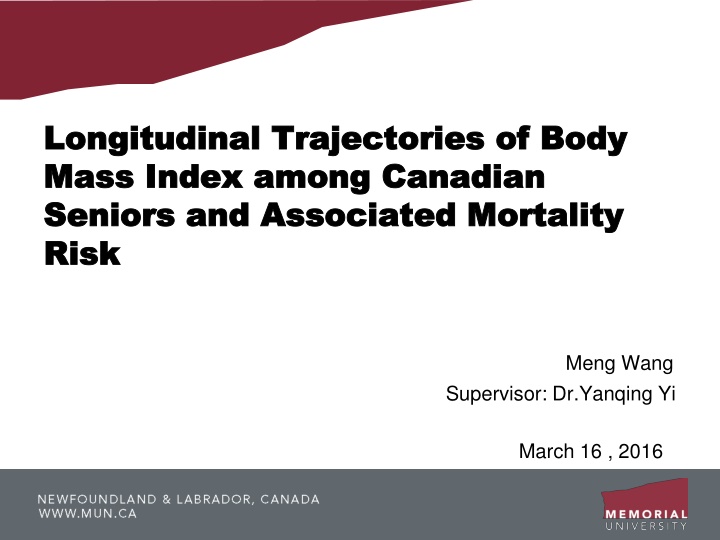
Canadian Seniors BMI Trajectories and Mortality Risk Study
Explore the longitudinal trajectories of Body Mass Index (BMI) among Canadian seniors and their associated mortality risk. Understanding the natural history of weight change and identifying diverse BMI trajectories using Latent-Class Growth Modeling (LCGM) can provide insights into factors affecting seniors' health and mortality risk.
Download Presentation

Please find below an Image/Link to download the presentation.
The content on the website is provided AS IS for your information and personal use only. It may not be sold, licensed, or shared on other websites without obtaining consent from the author. If you encounter any issues during the download, it is possible that the publisher has removed the file from their server.
You are allowed to download the files provided on this website for personal or commercial use, subject to the condition that they are used lawfully. All files are the property of their respective owners.
The content on the website is provided AS IS for your information and personal use only. It may not be sold, licensed, or shared on other websites without obtaining consent from the author.
E N D
Presentation Transcript
Longitudinal Trajectories of Body Longitudinal Trajectories of Body Mass Index among Canadian Mass Index among Canadian Seniors and Associated Mortality Seniors and Associated Mortality R Risk isk Meng Wang Supervisor: Dr.Yanqing Yi March 16 , 2016
Outline Background Background Objectives Objectives Methods Methods Findings Findings Limitations Limitations Conclusion Conclusion
Outline Background Background Objectives Objectives Methods Methods Findings Findings Limitations Limitations Conclusion Conclusion
Background A trajectory is defined as the evolution of an outcome over age or time Why BMI Traj better understand the natural history of weight change New insights on multiple factors of obesity may reflect people s health trajectory, mortality risk
a single average trajectory Limitations of conventional growth model too simplistic considering population heterogeneity Latent-Class Growth Modeling Identify different BMI trajectories capture the heterogeneity
LCGM Identify multiple BMI trajectories, assigns each individual to a specific trajectory which has the maximum probability of belonging to this class LCGM can handle time- and age-based data and it is a data-drive method used to test whether the anticipated latent trajectories emerge from the data itself
Background Aging and obesity among the elderly is rising Excess body weight is associated with an increased risk of mortality in young to middle- aged adults Seniors: J or U-shaped, positive linear, static or limited BMI measurements
Outline Background Background Objectives Objectives Methods Methods Findings Findings Limitations Limitations Conclusion Conclusion
Objectives 1. Apply LCGM to identify different BMI trajectories in an 18-year longitudinal study of a national cohort of seniors 2. Examine the mortality risk associated with these BMI trajectories
Outline Background Background Objectives Objectives Methods Methods Findings Findings Limitations Limitations Conclusion Conclusion
Methods NPHS, Biennial, from 1994/95- 2010/11 (9 cycles) 69.7% response rate in cycle 9 Of the 1480 individuals , include aged 65-79 years at baseline have at least four BMI records LCGM & cox regression(SAS) Time var-age, ALD; Trajectory var- BMI Source:
Variables Survival Time Year of death and month of death Age, race (White vs. non-White), education (high school), presence of disabilities Covariates Physical activity trajectory groups Smoking and drinking Traj groups The Traj of the number of chronic conditions
Outline Background Background Objectives Objectives Methods Methods Findings Findings Limitations Limitations Conclusion Conclusion
Figure 1 BMI trajectories for men (65-96 years), with 95% CI NPHS, 1994-2011.
Figure 2 BMI trajectories for women (65-96 years), with 95% CI, NPHS, 1994-2011.
Findings Normal Weight-Down(N-D), Overweight- Normal weight (OV-N), Obese I-Down(OB I-D), and Obese II- Down (OB II-D) for women; and Normal Weight-Down(N-D), Overweight-Normal weight (OV-N), Overweight-Stable (OV-S), and Obese- Stable (OB-S) for men.
Findings Three downward BMI trajectories for aged 65 to 105-a community sample. Zheng et al. found one decreasing and five increasing for aged 51 to 77. Age groups considered Body weight increases up to the age of 70 years, then stabilizes or decreases.
Table 1 For the Cox regression model (Unadjusted). BMI trajectory group P-value N (%) HR (95%CI) 268 (50.4) 1.00 (referent) OV-N N-D 78 (69.7) 1.86 (1.36-2.54) <.0001 171 (48.9) 1.13 (0.84-1.51) 0.41 OV-S OB-S 43 (69.2) 1.97 (1.26-3.07) 0.003
Table 1 For the Cox regression model (Partially and Fully Adjusted) Partially adjusted Fully adjusted BMI trajectory group P-value P-value HR (95%CI) HR (95%CI) 1.00 (referent) 1.00 (referent) OV-N N-D 1.94 (1.41-2.65) <.0001 1.66 (1.20-2.29) 0.003 1.19 (0.88-1.60) 0.25 1.25 (0.92-1.67) 0.15 OV-S OB-S 2.01 (1.28-3.14) 0.002 1.98 (1.28-3.16) 0.003
Findings N-D and OB-S were associated with an 86% (P < 0.001) and 97% (P < 0.05) increase in mortality risk in the unadjusted model among men. Adjustment for age, race/ethnicity, and educational attainment had a minor effect on the HRs No such correspondingly association was observed among women.
Findings OV-N has the lowest mortality risk followed by N-D and OB-S. Men who were overweight at age 65 and lost weight over time but never reached underweight had the lowest mortality risk. Men who were obese at age 65 and remained obese had the highest mortality risk
Findings The results indicate that the mortality differences between OV-S and OV-N were not sig. This suggests that being overweight in the later years of life may be unrelated to lowering the probability of survival.
Outline Background Background Objectives Objectives Methods Methods Findings Findings Limitations Limitations Conclusion Conclusion
Limitations Self-reported data, BMI-if reliable tool Selection bias. The individuals could be healthier than the average person Intentional and unintentional weight loss was not available from the NPHS
Outline Background Background Objectives Objectives Methods Methods Findings Findings Limitations Limitations Conclusion Conclusion
Conclusion Heterogeneity within different BMI trajectories was found among Canadian men and women. Men overweight at age 65, lost weight over time but no underweight had the lowest risk of mortality. Provide new insights into the debate concerning the associations between BMI and mortality risk among seniors
References 2. Finkelstein EA, Fiebelkorn IC, Wang G: National medical spending attributable to overweight and obesity: how much, and who's paying? Health Aff (Millwood) 2003, Suppl Web Exclusives:W3-219-26. 3. de Mutsert R, Sun Q, Willett WC, Hu FB, van Dam RM: Overweight in early adulthood, adult weight change, and risk of type 2 diabetes, cardiovascular diseases, and certain cancers in men: a cohort study. Am J Epidemiol 2014, 179(11):1353- 1365. 4. Zhang X, Shu XO, Chow WH, Yang G, Li H, Gao J, Gao YT, Zheng W: Body mass index at various ages and mortality in Chinese women: impact of potential methodological biases. Int J Obes (Lond) 2008, 32(7):1130-1136. 5. Flegal KM: Excess deaths associated with underweight, overweight, and obesity. JAMA : the journal of the American Medical Association 2005, 293(15):1861; 1861-1867; 1867. 6. Gu D, He J, Duan X, Reynolds K, Wu X, Chen J, Huang G, Chen CS, Whelton PK: Body weight and mortality among men and women in China. JAMA 2006, 295(7):776-783. 7. Manson JE, Willett WC, Stampfer MJ, Colditz GA, Hunter DJ, Hankinson SE, Hennekens CH, Speizer FE: Body weight and mortality among women. N Engl J Med 1995, 333(11):677-685. 8. Corrada MM, Kawas CH, Mozaffar F, Paganini-Hill A: Association of body mass index and weight change with all-cause mortality in the elderly. Am J Epidemiol 2006, 163(10):938-949. 9. Walter S, Kunst A, Mackenbach J, Hofman A, Tiemeier H: Mortality and disability: the effect of overweight and obesity. Int J Obes (Lond) 2009, 33(12):1410-1418. 10. Myrskyla M, Chang VW: Weight change, initial BMI, and mortality among middle- and older-aged adults. Epidemiology 2009, 20(6):840-848. 11. Orpana HM, Berthelot JM, Kaplan MS, Feeny DH, McFarland B, Ross NA: BMI and mortality: results from a national longitudinal study of Canadian adults. Obesity (Silver Spring) 2010, 18(1):214-218. 12. Zheng H, Tumin D, Qian Z: Obesity and mortality risk: new findings from body mass index trajectories. Am J Epidemiol 2013, 178(11):1591-1599. 13. Somes GW, Kritchevsky SB, Shorr RI, Pahor M, Applegate WB: Body mass index, weight change, and death in older adults: the systolic hypertension in the elderly program. Am J Epidemiol 2002, 156(2):132-138. 14. Oksuzyan A, Juel K, Vaupel JW, Christensen K: Men: good health and high mortality. Sex differences in health and aging. Aging Clin Exp Res 2008, 20(2):91-102.
Questions Questions ?






















